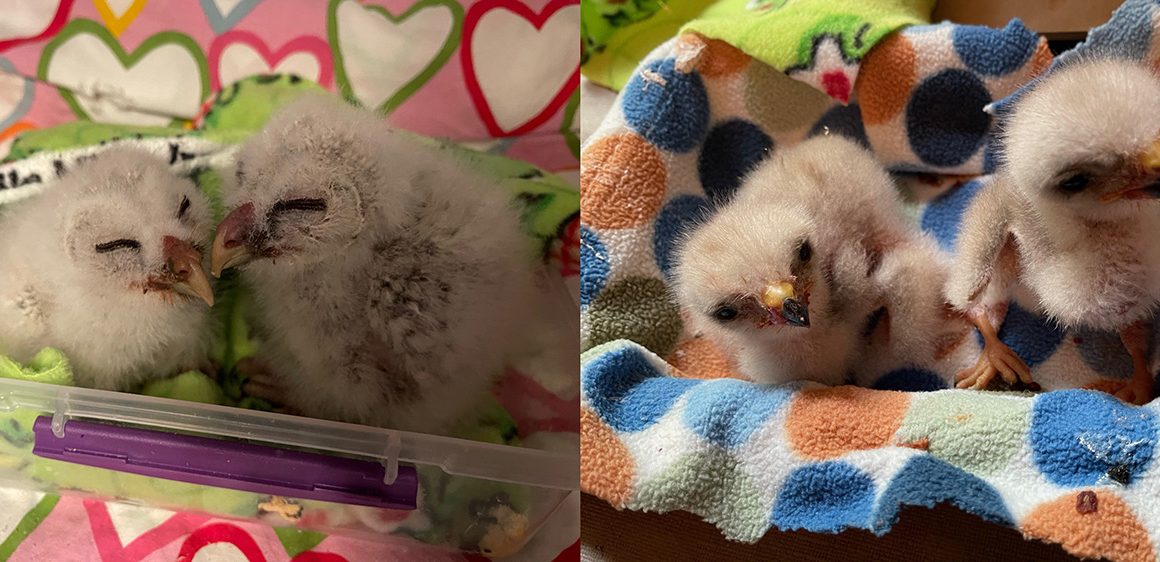
It’s a beautiful Spring morning… humming insects, calling birds. But then you hear the rev of a chainsaw, followed by the ripping sound of a falling tree. The thud sounds awfully close, so you rush to your window and discover it’s your family’s beloved old maple – only you didn’t hire anyone to take it down.
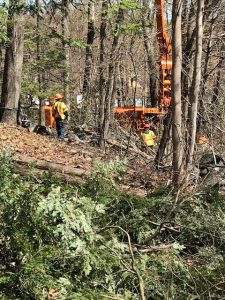
The person in charge says they’ve been hired by the power company to clear the area around the poles and lines. They say the power company has an easement on your property, so there’s nothing you can do.
Is this true? No.
Well… it’s true if your tree is already lying on the ground, although if you’re a lawyer you can pursue it. But there are ways to prevent this situation, and to prevent the constant springtime problem of wildlife being orphaned… like these Barred Owls, above left, and Red-Shouldered Hawks, all of whom were delivered as eggs to Christine’s Critters in Weston, CT, thanks to two different private homeowners’ felling of trees.
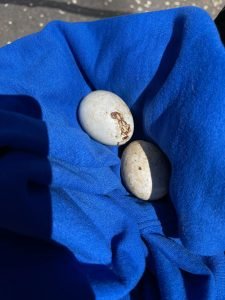
But back to power companies.
Maggie Ciarcia, a solo wildlife rehabilitator in Carmel, NY specializing in small mammals and game birds, received a notice from New York State Electric and Gas that tree trimming was scheduled for her neighborhood and someone would contact her. One morning crews simply showed up and dropped everything within ten feet of the powerlines. “These were big trees!” she said. “Some were 40 feet!”
I called my current power company, Central Hudson, and asked about their protocol for nesting wildlife. “We’ve never had any problem,” said the woman, whose job is to answer basic informational questions from customers.
“What if you did?” I asked.
“Then the crew would call us, and we would find someone to help,” she said.
“Do you have a list of people to call?” I asked.
“No,” she answered.
“What would happen if you notified me that you were going to cut trees on my land, and I said no way?” I asked.
“We don’t have to notify you,” she replied.
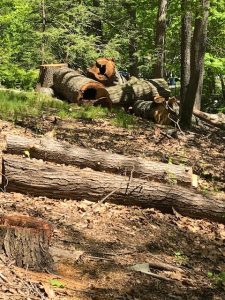
You see how this goes?
Power companies can be extremely responsive when it comes to birds being electrocuted on their poles. Cutting down trees around their lines is a different story.
Tree limbs falling on transmission or distribution wires can take out thousands of customers. All power companies are overseen by NERC, the North American Electrical Reliability Corporation, which has their own rules about “vegetative management.” Certain states can have a second regulatory agency layer when it comes to high-voltage transmission lines.
All this is why power companies will try to ignore you if you scream at them about nesting wildlife: because compared to the number of people screaming at them about electricity outages, yours is a relatively lonely voice. So:
1) Jump the gun. If there are trees on your property near power lines, call your power company and be a pest until you speak to a person with authority – not just someone answering the phone. When they tell you they comply with local environmental agencies, tell them you do too, and ask if they can reschedule cutting for the fall, or cut only certain limbs. Mention your attorney friends and relatives. Power companies count on people offering no resistance, and it makes more business sense for them to work with you than actively against you.
2) React quickly to notices. As Maggie discovered the hard way, when a company alerts you to impending cutting and says they’ll contact you, don’t wait. Call them immediately.
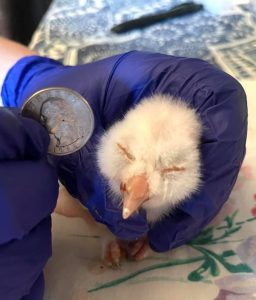
3) Investigate creating a town ordinance. There are towns – normally ones filled with lawyers and loud environmentalists – which require tree companies to obtain a permit before taking down any tree over a certain diameter. Contact your Town Board, Zoning Board, or, if you have one, Conservation Advisory Board, and ask about implementing such laws.
4) Dream of the European model. Jochen Roeder, a former fellow 10,000 Birds writer who lives in Germany, says according to EU nature conservation directives it’s illegal to cut down trees during the spring and summer unless they are checked by an expert for nesting birds or resting bats. The companies have to cover the costs of hiring experts and consultants. No wildlife rescue required. Ah, Europe!
5) Keep your phone handy, even if it’s not your property. Cathy Cudmore, who helps rehabbers with hummingbird transport in Arizona, points out that while power companies may have easements, disturbing an active bird nest is a violation of the Migratory Bird Treaty Act and thus a crime. Film the tree cutting, get the name of the tree company, and report it to the Law Enforcement Office of the U.S. Fish & Wildlife Service. You can also report it to your state Department of Environmental Conservation, Department of Environmental Protection, or Fish and Game. This goes for private landowners’ cutting of trees as well.
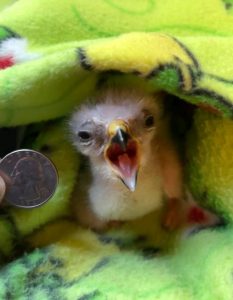
5) Display attitude. Beth McMaster, a wildlife rehabilitator with Wildbird Recovery in Western Pennsylvania, says the first time a crew arrived she threatened to chain herself to one of her trees. Things escalated and five supervisors arrived in short order. “This has been going on for years,” says Beth. “Now every time they come here I have to be in attendance, and give them permission to cut each branch. Yes, they hate me – but I saved the trees.”
You’re not trying to shut down the grid – you’re just trying to get them to move their trimming/cutting activities in your corner of the world to the fall, when nesting season is over, or at least cut limbs, not the entire tree.
The orphans above were the result of private landowners knowingly cutting down active nests. Thanks to Christine’s Critters (Christine pictured below) four eggs hatched and became healthy nestlings. For the full story – sad, infuriating, but with the happiest of possible endings under the circumstances, see intoBirds. And don’t forget rehab centers run on donations, which are tax deductible.
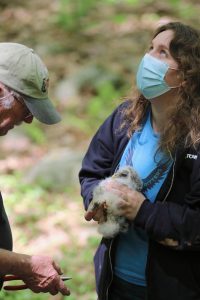
Banner photo taken by Christine’s Critters and arranged by intoBirds. Second and third photos by Maggie Ciarcia. Final three photos by Christine’s Critters.













This needs to be reposted to social media immediately. Thank you!
Oh, oh, the system made a mess of my name — John Burridge of East Providence, Rhode Island, USA
Hello John Burridge – Thanks, and feel free to repost!